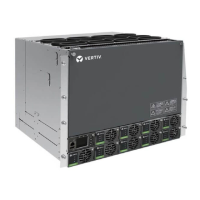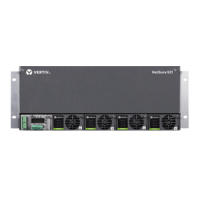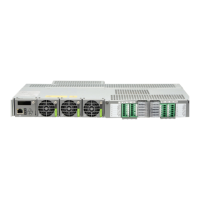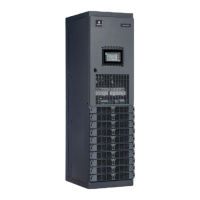Vertiv™ NetSure™ 7100 Series -48 VDC Power System User Manual
Optional Manual Battery Disconnect Circuit Card Replacement
Procedure
1. Performing this procedure may activate external alarms. Do one of the following. If possible, disable these alarms. If these
alarms cannot be easily disabled, notify the appropriate personnel to disregard any future alarms associated with this system
while the procedure is being performed.
DANGER! Performing the next steps exposes service personnel to battery potential. Exercise extreme caution not to
inadvertently contact or have any tool inadvertently contact any energized electrical termination.
2. Open the distribution cabinet’s front door by turning the latch in the counterclockwise position (system’s in a relay rack) or
open the system’s enclosure door.
WARNING! Damage to the circuit card may result if the next step is not followed.
3. Connect an approved grounding strap to your wrist. Attach the other end to a suitable ground.
4. Remove the top and front panels to access the circuit cards at the bottom of the distribution cabinet.
5. Carefully label the connectors plugged into the circuit card. These connectors must be plugged into the same connectors on
the replacement circuit card. Refer to Figure 5.22.
6. Unplug all connectors plugged into the circuit card.
7. Remove the screws securing the circuit card and remove the circuit card from the distribution cabinet.
8. Place the replacement circuit card into the mounting position inside the distribution cabinet, and secure with the screws
removed from the old circuit card.
9. Plug all connectors removed from the old circuit card into the same position on the replacement circuit card.
10. Remove the grounding wrist strap.
11. Reinstall the top and front panels that cover the circuit cards at the bottom of the distribution cabinet.
12. Close the distribution cabinet’s front door and turn the latch clockwise to secure the door (system’s in a relay rack) or close
the system’s enclosure door.
13. Enable the external alarms or notify appropriate personnel that this procedure is finished.
14. Ensure that there are no local or remote alarms active on the system.
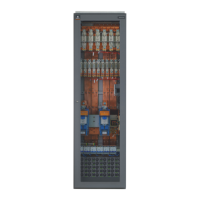
